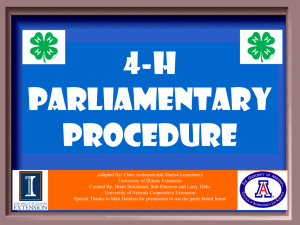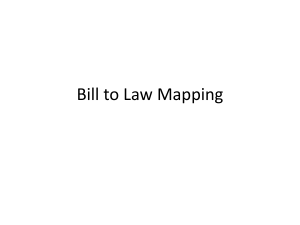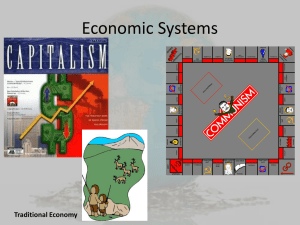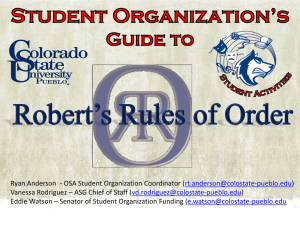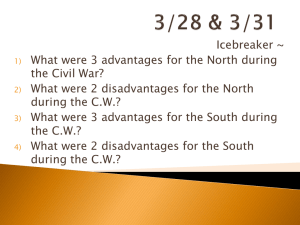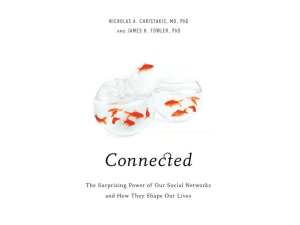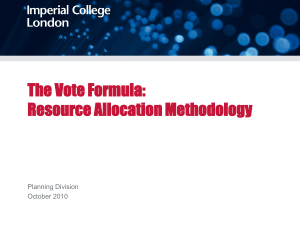CH 8 Forming Public Opinion
advertisement
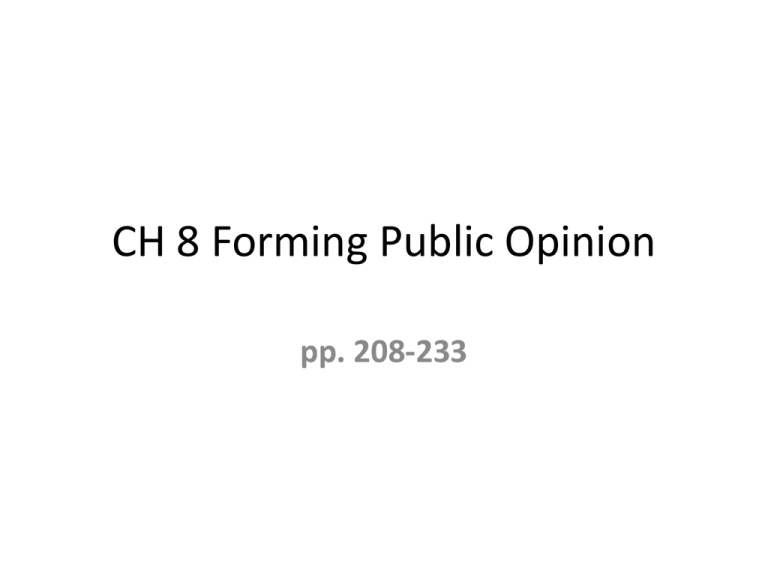
CH 8 Forming Public Opinion pp. 208-233 Copy • In order to do its job, the government must know what is important to the American public. • It must watch and listen to the people and the media • It must weigh the direction of events • Only then can it debate and decide policies to deal with public needs. • Public Affairs • 208 politics, public issues, making of public policy EC: What might be a public affairs issue today? (1 for each) – Social: • • • • • – Military • • • • • – Use of drones (surveillance and attack) in the US Spying on US citizen communications Dealing with domestic terror Cyber attacks on US internet Economic: • • • – Use of drones (surveillance and attack) North Korea Dealing with foreign terror Cyber attacks on US internet Russian and Chinese aggression in their parts of the world. National Security • • • • – LGBTQ marriage/equality Abortion Religious right to deny fair labor rights Open-carry and stand-your-ground gun laws. immigration unemployment. Job creation Minimum wage Health: • • • Parental right NOT to vaccinate their child(ren) Affordable health care for all Americans Right to choose NOT to vaccinate one’s children – Entertainment: – Sports: • • Smoking in movies Use of steroids by athletes Copy: • Much public opinion is started by the media, planned and unplanned. Public opinion • 209 Thoughts many people in common have about what their government and politicians are and should be doing. • Views on things like: – – – – – – Political parties/candidates taxes Unemployment Welfare programs, National defense Foreign policy Opinion leader • 212 Any person who has a strong influence on the way many Americans think. – Politicians – Media commentators/pundits – Entertainers/athletes – Single-issue personality Mass media • 211 means of communication that can reach large, far-flung audiences at the same time. – Brochures, pamphlets – Newspapers – Radio – TV – Internet – Twitter mandate • 216 idea that the winner of an election has been given permission to rule everyone in the country. • Implies that the majority are satisfied • Implies that opposition be silent and not oppose that leader. Copy • The people (business, private groups) themselves also make conscious pushes to promote and achieve their special interests Interest group • 216 private organizations with members who share the same political thinking or views. – They use their money to sponsor ads, help candidates and parties – They spread the word to their members to take action • How to vote • Aka: • pressure groups, • special interest groups – Nov, 2011 GOP Presidential candidates woo the Jewish vote. – EC: What Jewish interest group were they speaking to? • American Jewish Republicans who support Israel. Polls • Sample • 218 The group a polling person selects to get an idea of what all people are thinking. • Straw vote • 217 pollster asks as many people as possible the same questions and writes the results. – Little or no arrangement or organization is made. • Radio talk show • Movie line sample Polling • Random sample • 218 pollster interviews a group selected by chance, in places also selected by chance. – Based on mathematical law of probability. – Most common type of poll • Has proven the most reliable • Quota sample • 219 planned grouping based on ethnic/gender/socioeconomic percentages; – Not as reliable since many people do not fit one category. Public agenda • 228 The national, state, local issues that politicians and general society believe need government attention….. – – – – – Financial regulation LGBTQ rights/marriage Undocumented aliens Terrorism preparation and response Affordable Care Act (Jimmy’s street poll points out public awareness (remember, the media use the interesting/allowed bits, not every response is shown) – Etc. Sound bite • 230 short quotes used in news reports and ads – Some become memorable/infamous • Franklin Roosevelt – Depression • John F. Kennedy – Country • Ronald Reagan -- thought mic was off. Medium • Any means that passes a message from a source to a viewer/listener – TV – Newspaper – Radio – Magazine – Internet Egypt • Just how influential are Internet/Smart phone social media? • The woman who is credited with spawning the demonstrations against the Mubarak Regime with an impassioned call to viewers and the world….. • Another woman speaks on Jan. 31 – The first sign says "Down with the dictatorial regime" – the second says "Little is remaining" meaning we are so close to our goal. – the third one on cardboard says: "Leave so that the martyrs' families can restand their chest pain be relieved". – fourth: "Every egyptian, go and hang on your house door - WE DON'T WANT YOU" – Hope that was helpful - PROUD TO BE EGYPTIAN • Mubarak’s speech one night • The next day after Mubarak’s response. Hwk Concepts, Class Work, to Know Concepts: Ch. 8, pp. 208-233 • EC: How might young children be politically socialized? (3) – 208 families – Experience in school – Mass media EC: What evidence can you give that the mass media have access to influence public opinion? • 208 The Number of in-home/personal – TVs, – radios, – computers, – smart phones EC: Why are interest groups uncertain gauges for measuring public opinion? • 215 number of people represented by polled persons is unknown – Strength of views held is also unknown EC: What is the major problem with a straw vote poll? (2) • 215 relies on quantity rather than quality of the sample – Does not guarantee an accurate cross-section of the population EC: Why is the random sample considered a fairly accurate representation of public opinion? (3) • 215 It relies on the law of probability – Properly selected groups – Small and predictable margin of error. EC: For what reasons is public opinion measured? (2) • 215 so it can have an influence on public policy – Part of a true democracy EC: Why is the Internet considered a medium? 223 transmits messages and information to many, on-demand, rapidly. EC: How do the media influence the public agenda? (3) • 223 Help determine public issues that concern most people – Focus broadcasts on those issues • Can repeat as often as needed – Influence public-policy makers viewing broadcasts • Polls • Editorials • “debates” – EC: What is the main principle behind using the courts even though the majority of voters wanted a law passed to stop that law from going into effect? – EC: What is the main principle behind keeping the courts out of laws made by local majority will? – Same-sex marriage EC: How do the media influence the public agenda? (3) • EC: What is the main principle behind using the courts even though the majority of voters wanted a law passed to stop that law from going into effect? – Majority-will laws can take away a citizen’s private Constitutional rights • EC: What is the main principle behind keeping the courts out of laws made by majority will? – Court decisions can take away the Constitutional rights of the “majority” to protect themselves through legislation in their locality. Ex: power of media on public opinion and public agenda-• • Jon Stewart, on a cable comedy show, decided to speak out on a bill in late 2010. The bill was to provide a multi-billion dollar fund for first-responders to the 9/11 attack sites in New York and Washington, DC. – Many of the workers, only 9 years later are experience accelerated debilitating and fatal diseases from the many substances they were exposed to for quite a while after the event. • Republicans, who talked about patriotism and how they defended this nation after 9/11, and even claimed support for the people who bravely responded to save lives on 9/11, unanimously voted ‘NO’ on the bill. – Saying it was too expensive. • Stewart raised some points with his audience. – The video went viral, beyond his cable show and web page. – The regular press picked it up and repeated the story….. – People got angry and wrote to their representatives….. • • The vote was retaken and Republicans amazingly vote ‘YES’ and approve the exact same bill into law….. That is media influence on the public agenda….. EC: What limits are there on media influence? (4) • 223 most people do not follow it closely – Audience selects sources – Content often based on entertainment value – Coverage is often not in-depth Images: CH 8 • 209, spectrum questions • a. • Liberals tend to support expansion of social welfare • Conservatives oppose the expansion and favor less government – Want traditional social structure • b. • variable Images: CH 8 • 209, (cartoon) question • Though the political spectrum may be seen as very broad, most Americans don’t see huge differences in the points on it. Images: CH 8 • 212, question, • 98% of American households have TV sets. • + Is TV the main way campaigns reach people? Explain. • Variable (radio another common tool) • + what is missing? – Billboards, – yard signs Images: CH 8 • • • • • 214: questions 1. Hispanics have a half-trillion dollar purchasing power 2. Issues important to Hispanics will get more publicity – Public opinion is shaped by extended coverage • 3. • They might look for work where other Hispanics are. – Others might seek bilingual opportunities. Images: CH 8 • • • • • 219: questions A. Question 1 B. 2 & 3 are the same, their wording produced vastly different results, – suggesting bias. Images: CH 8 • 221: questions • A. • that people believe participating in polls is more important than voting • B. • refutes it, by saying that public opinion can not replace voting in a democracy. Images: CH 8 • • • • • 233: questions 30. presidential candidates 31. that it reduces debate to simple name-calling. Images: CH 8 • 225: questions • Although the Internet has grown in the last few years, other media still are effective in news and opinion dissemination – Most likely: • Radio • TV Images: CH 8 • 226: questions • Increase in the number of radio stations may provide more opportunities for spreading new messages – Language – Age – Ethnicity What basic emotions to the media makers use to make the point, x3 (3 pts/each) • Write at least three emotions, cite an example from a commercial (must be a different commercial for each). • Once you identify one emotion, do not use it again from another ad. • 6 points total = 3 emotions/examples. Political Ads • Candidate – LBJ (run once, but made people fear Barry Goldwater) – Hillary (implying Obama was not experienced to handle an international emergency) – – – – Tim James Vernon Robinson Sharron Angle Dan Fanelli; 2 • PAC/Outside group – NRA (National Rifle Association) What basic emotions to the media makers use to make the point (6) • • • • • • • Fear Cynicism Trust Patriotism Racism Hate/intolerance Maybe you something distinctly different? What makes public opinion so difficult to ascertain? • Public opinion is hard to determine because there are so many topics and issues on which people can hold opinions and so many different groups and categories to which each person can belong. – People can change their opinions suddenly. – People sometimes even hold contradictory opinions without realizing it. How can an opinion held by the public NOT be a public opinion? • The definition of the term public opinion requires that the opinion be related to political or governmental attitudes, not to attitudes about other aspects of life. – Many people can believe that cats are the best pets, but since the belief does not affect public policy, it cannot be called a public opinion. The text states that election results are seldom an accurate measure of public opinion. Explain why you agree or disagree with this statement. • Because so many factors influence voting, it is impossible to know for sure. – Many issues other than public opinion affect whom a voter will vote for in an election. – Party identification and personal preference may draw a vote that is not based on issues. Brief response • What form of media do most people your age get their public awareness from? Cite a current example of a public issue you are aware of through this medium.


